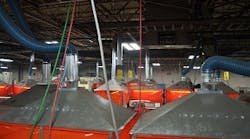Previously, each weld cell had its own dust collector mounted on top. This layout resulted in sparks being sucked directly into the collector, frequently resulting in fires. Mobility was also a concern. The top-mounted collectors made it time-consuming to move the weld cells, and maintenance was difficult because a lift had to be used for filter change-out. The energy to run numerous blowers and produce compressed air for each dust collector also added up.
Central system
The central system design has returned mobility to the customer. “Now all we do is pull a couple of pins, undo a couple of clamps, remove the hood, and move it where we want to move it,” says Chuck Pratt, Toyo Seat maintenance supervisor. Toyo Seat expects to save over $30,000 a year.
As an added precaution, a sprinkler system is used inside each dust collector, as well as flame retardant HemiPleat Gold Cone filters. To save on energy costs, a variable frequency drive (VFD) controller is used.
